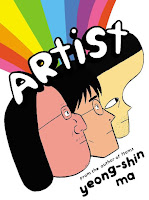In August, I took my first trip to Washington DC. It was my
first thought after getting home last year from a great visit to Gettysburg PA.
"Where should I go next year?" The choice of Washington DC was made
easier by the fact that it's a direct flight from our overlooked, medium-sized
town. Easy to get to from here. I'd always wanted to go. I've talked to many
who visited before, and often it was their senior trip in high school. My class
went to the Poconos. I sat out that trip--my protest vote.
 |
| View from the Lincoln Memorial steps |
Never have I heard more of a variety of languages and
accents than in DC. There was a group of students from France (probably middle
school age) passing on the left. There was a group from Sweden going the
opposite direction. There was a family that spoke what sounded like an eastern
European language. There were a few people with an African cadence. The Middle
East. Asia. The multiplicity was dizzying. It gave me hope that, even though we
have a brain-dead autocrat in office, the rest of the world still looks to the
US as an ideal. I've known this, but never experienced it around myself in such
a tangible fashion.
I saw most of the major monuments. I lingered on the steps
of the Lincoln Memorial, trying to conjure up that day in 1963 when Dr. King
spoke. It felt like I was on America's front step. People sat on the steps and
milled in front, quietly taking it all in. There were signs that
asked for
quiet as a sign of respect for the monuments. They were largely heeded. The
view from the steps, across the reflecting pool through the World War II
monument and on to the Washington Monument, can't help but inspire. The sordid
part of this country's history is never far from my mind, but that spot made it
recede for a little while. Here we were, ready once again to rise above it,
like we did in 2008. Or will we? The racist and nationalist strains in American
life are never far from the surface.
The Vietnam Veterans Memorial (notice: "Veterans",
not "War") has always been transgressive as far as memorials go.
There were the statues of three soldiers as you enter, but the main part is a
black wall with the names of those who died during the long conflict. The wall descends
slowly into the ground, evoking the quagmire that the war became. The names
pile up as the wall lengthens and deepens towards its midsection. There were
others there looking for names they knew. The earliest
year for names is 1959,
the last 1975. Even I remember that last year, with the image of the Huey on
the roof of the American embassy. All that time and effort, all those lives,
only to end up in an ignominious bug-out from Saigon, many South Vietnamese
begging to come along. Maybe things would've been different if the rationale
for the war, the supposed attack in the Gulf of Tonkin on two destroyers, had
never been invented in the first place. |
| SS-20 on the left; Minuteman on the right |
I suffered museum fatigue by the end of the trip. There are
so many. The two highlights were the Air and Space Museum, and the Museum of
Natural History. The instantly recognizable icons of the early days of
aviation, and the space race. A replica of the lunar lander greets you as you
walk in, the actual lander still sitting forlornly on the moon. Its body
insect-like and partly covered in gold-colored insulation. When cast mentally
against the vast cold vacuum of space, it looks almost inadequate. Yet it
succeeded. There are ICBMs, both US and Russian. There are the German vengeance
weapons from World War II, the V-1 and V-2. The V-1 is small, basically an
early drone, but one can draw a direct line between the V-2 and the later US
Minuteman ICBM. Too much was learned from the losers in that war. Werner Von
Braun, the German rocket designer responsible for Hitler's terror weapons, has
his
fingerprints on both weapons.
 |
| V-2 rocket |
I saw the dinosaurs in the Museum of Natural History.
Tyrannosaurus Rex bathed in a lurid red glow. Stegosaurus and Triceratops and
Diplodocus, all were once part of my plastic playset. Here were the actual
bones, proof positive that these megafauna really did roam the same lands we
now walk. For all their fearsome reputation, it only took one asteroid to wipe
them out and open the way for mammals. No one at the exhibits seemed to be
thinking that the same cataclysmic event could happen to us. Despite our big
brains, we are not favored. In fact, because of our big brains, we stand an
arguably better chance of doing ourselves in. Who needs an asteroid when you've
got rampant consumption of fossil fuels, the product of ancient decomposing
plant matter? Thanks to us, the Cretaceous period may have the last laugh yet.











